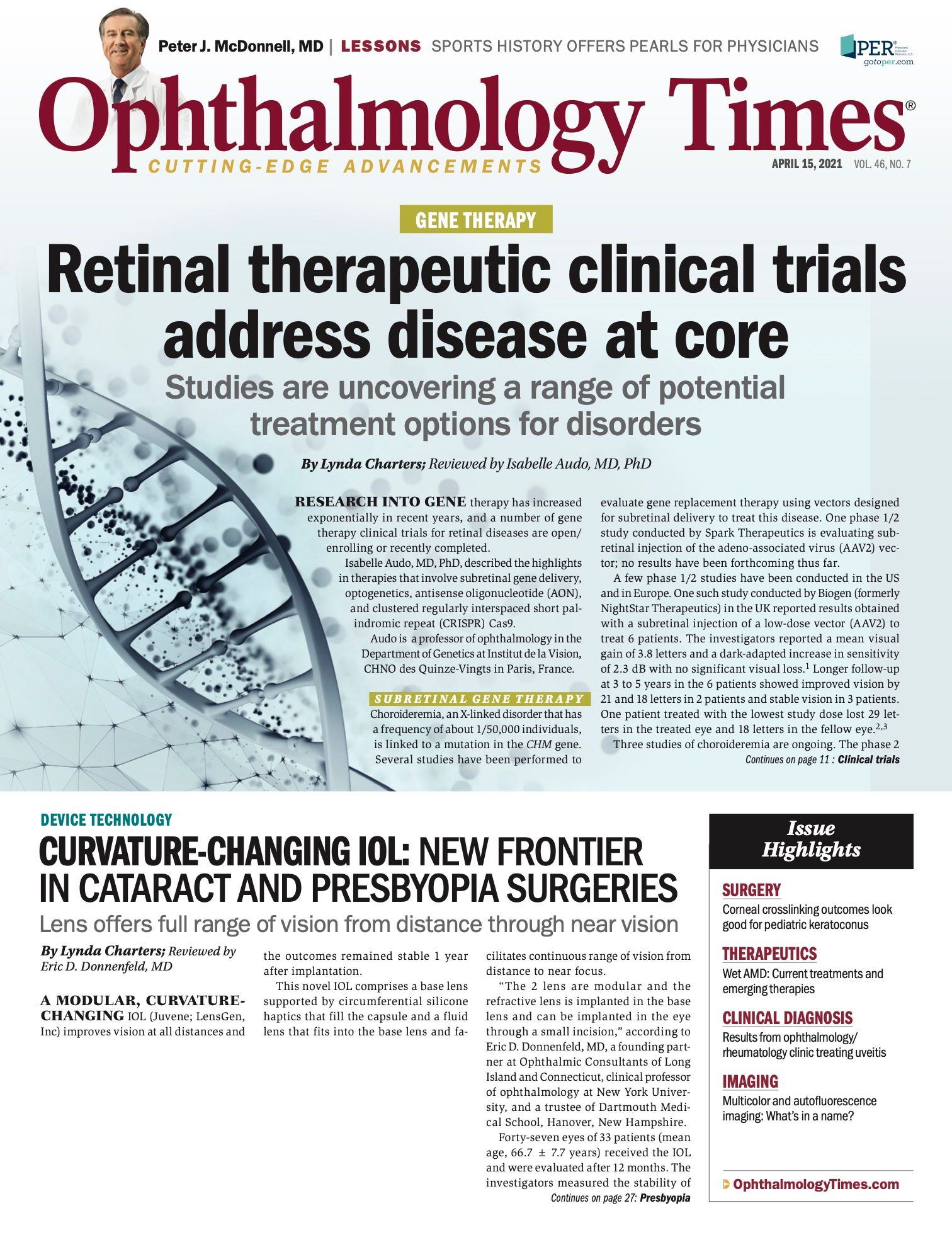Publication
Article
Digital Edition
Study confirms efficacy of uveitis treatment
Author(s):
Dexamethasone implant is key to treating non-infectious posterior segment uveitis.

Bodaghi

Reviewed by Bahram Bodaghi, MD, PhD
Findings in LOUVRE 2, a French postmarketing, prospective, observational study, confirm the real-world efficacy of the dexamethasone 0.7 mg intravitreal implant (Ozurdex, Allergan) for treating relatively long-standing non-infectious posterior segment uveitis.
The findings also provide insight into the characteristics of patients ophthalmologists choose for treatment with the sustained-release corticosteroid implant, according to Bahram Bodaghi, MD, PhD.
“Noninfectious posterior segment uveitis [NIPU] is the least common form of uveitis, yet it is the most vision-threatening form,” he said. “In addition to its potential to cause sudden/severe vision loss, it can be associated with painful symptoms. Because of its sequelae, NIPU can lead to a marked decrease in quality of life.”
Related: Should nonclinicians inject dexamethasone implants?
Bodaghi noted that in this cohort of patients seen in routine clinical practice, consisting mostly of individuals previously treated for uveitis for an average of 5 years, the intravitreal dexamethasone implant maintained its functional and anatomic efficacy.
Bodaghi is professor and chairman of the Department of Ophthalmology at Sorbonne University in Paris and an investigator in the LOUVRE 2 study (NCT02951975).
“In addition, the tolerability of the steroid implant treatment was consistent with what has been reported in the literature,” Bodaghi said.
“With its approval in July 2010, the dexamethasone intravitreal implant became the first specialized treatment for NIPU in Europe,” he explained. “Thereafter, the prospective, multicenter, observational LOUVRE 2 study was implemented in France to evaluate the real-world efficacy, safety, and use of the implant in patients affected by NIPU.”
The study enrolled consecutively presenting patients with inflammation of the posterior ocular segment due to NIPU.
Twenty randomly selected injection centers participated in the study. Both treatment-naïve and previously treated patients were eligible for enrollment.
Related: Study: Innovative dexamethasone formulation shows efficacy, safety
Patients who were treated with the dexamethasone implant on study entry could be retreated with the implant and/or alternative therapies during follow-up.
According to the protocol, outcomes would be analyzed using data from visits at months 2, 6, and 18 after patient enrollment.
A batch recall of the implant at the end of 2018 led to early termination of the study, and only a few patients reached the month 18 visit.
Efficacy assessments included changes in best corrected visual acuity (BCVA) and central retinal thickness (CRT). Safety evaluations reviewed AE reports.
Baseline data were available for 241 patients, including 97 who were treated with the dexamethasone implant at study entry. The patients who were treated with dexamethasone had on average a 5-year history of NIPU, and 80% had received prior treatment.
Related: Novel dexamethasone formulation shows efficacy and safety with once-daily use
Compared with the group of 144 patients that did not receive the implant, those treated who received the dexamethasone implant were 7.9 years older on average and had a thicker mean CRT (mean difference 91.2 µm).
In addition, the group treated with the dexamethasone implant included greater proportions of patients with cataract (20.0% difference), macular edema (26.2% difference), and inflammation-associated pathology (8.8% difference).
Half the patients treated with the dexamethasone implant at entry into LOUVRE 2 were not retreated at month 6, mainly because they had sufficient improvement of their disease state.
The proportion of dexamethasone-treated patients achieving a greater than or equal to 15-letter gain in BCVA from baseline was 25% at month 2 and 19.4% at month 6.
Related: Tackling the challenge of noninfectious uveitis
Mean improvement from baseline BCVA was 6.2 letters at 2 months and 4.3 letters at 6 months. Central retinal dryness was maintained at months 2 and 6 with mean decreases from baseline of 27.4 and 18.5 μm, respectively.
The observed functional gains are clinically relevant and were achieved despite prior treatment with the dexamethasone implant in 55.7% of the patients followed prospectively.
6g“These findings substantiate the efficacy of the dexamethasone implant for improving visual function among patients with NIPU in seen the clinical setting,” Bodaghi said.
The most frequently reported AE occurring in patients treated with the dexamethasone implant was transient ocular hypertension, which occurred at a rate of 6.9%. “This finding is similar to the experience reported with the dexamethasone implant in prior prospective and retrospective studies,” Bodaghi concluded.
--
Bahram Bodaghi, MD, PhD
e:Bahram.bodaghi@aphp.fr
Bodaghi is a consultant for Allergan, an AbbVie company; Alimera; Horus Pharma; Novartis and Santen.

Newsletter
Don’t miss out—get Ophthalmology Times updates on the latest clinical advancements and expert interviews, straight to your inbox.




